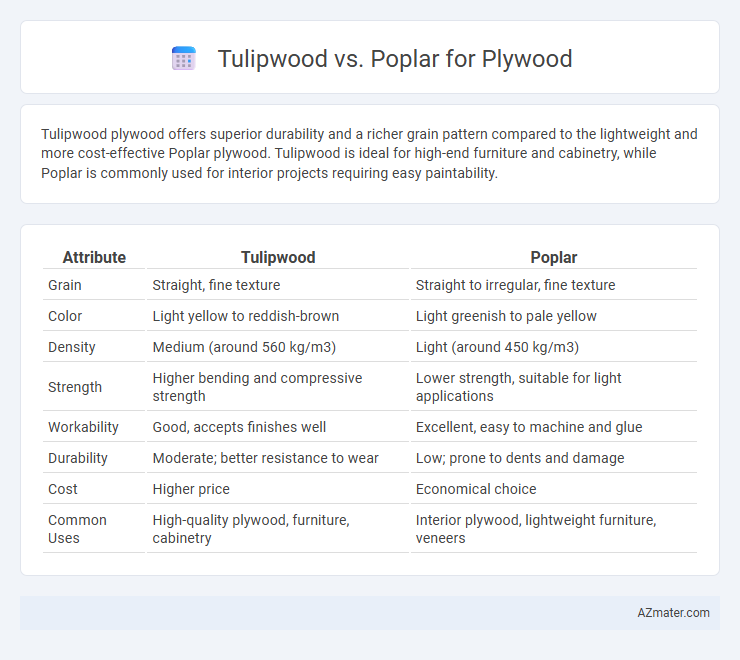Tulipwood plywood offers superior durability and a richer grain pattern compared to the lightweight and more cost-effective Poplar plywood. Tulipwood is ideal for high-end furniture and cabinetry, while Poplar is commonly used for interior projects requiring easy paintability.
Table of Comparison
| Attribute | Tulipwood | Poplar |
|---|---|---|
| Grain | Straight, fine texture | Straight to irregular, fine texture |
| Color | Light yellow to reddish-brown | Light greenish to pale yellow |
| Density | Medium (around 560 kg/m3) | Light (around 450 kg/m3) |
| Strength | Higher bending and compressive strength | Lower strength, suitable for light applications |
| Workability | Good, accepts finishes well | Excellent, easy to machine and glue |
| Durability | Moderate; better resistance to wear | Low; prone to dents and damage |
| Cost | Higher price | Economical choice |
| Common Uses | High-quality plywood, furniture, cabinetry | Interior plywood, lightweight furniture, veneers |
Introduction to Tulipwood and Poplar for Plywood
Tulipwood, known for its fine grain and light reddish-brown color, offers moderate hardness and durability, making it suitable for decorative plywood applications. Poplar, characterized by its straight grain and pale cream to light green hues, is softer and more affordable, often used in plywood for internal structures or furniture frames. Both woods are chosen for plywood based on strength requirements, appearance, and cost-efficiency in manufacturing.
Botanical Origins and Availability
Tulipwood plywood is derived from the Liriodendron tulipifera tree, native to eastern North America, characterized by its fine, straight grain and pale yellow to orangish hue, whereas Poplar plywood comes from various Populus species found throughout the Northern Hemisphere, known for its light color and uniform texture. Tulipwood tends to be less abundant and more costly due to limited geographic distribution and slower growth rates compared to Poplar, which grows rapidly and is widely available, making it a more economical option for plywood production. Both woods offer unique botanical traits influencing strength, workability, and aesthetic appeal, with availability directly impacting market price and application in woodworking projects.
Physical Properties Comparison
Tulipwood plywood offers higher density and greater hardness compared to poplar plywood, making it more resistant to denting and wear. Poplar plywood is lighter with a lower Janka hardness rating, providing easier machinability but less durability under heavy use. Moisture resistance of tulipwood is superior, contributing to better stability and less warping in humid conditions than poplar.
Workability and Machinability
Tulipwood plywood offers excellent workability due to its fine grain and consistent texture, allowing for smooth sanding and easy finishing. Poplar plywood features superior machinability with its softness, which reduces tool wear and enables clean cuts and precise detailing. Both woods provide reliable performance, but tulipwood is preferred for intricate joinery, while poplar excels in fast, efficient machining processes.
Appearance and Color Variations
Tulipwood plywood features a light tan to creamy yellow base with subtle pink or reddish hues, offering a warm, natural aesthetic ideal for decorative applications. Poplar plywood exhibits a pale cream to greenish or brownish tint with minimal grain patterns, providing a more uniform and neutral appearance suitable for paint or stain finishes. Both woods offer distinct color variations that influence design choices based on desired visual impact and finishing techniques.
Strength and Durability Analysis
Tulipwood plywood offers superior strength and durability due to its dense grain structure and high resistance to wear, making it ideal for heavy-duty applications and furniture requiring long-lasting performance. Poplar plywood, while lighter and more affordable, has lower strength and durability, making it suitable for interior projects where structural demands are minimal. The Janka hardness of tulipwood ranges around 540, significantly higher than poplar's 410, highlighting tulipwood's enhanced resistance to dents and impacts.
Cost and Market Value Overview
Tulipwood plywood generally commands a higher market value due to its durability and fine grain, making it popular for premium furniture and cabinetry. Poplar plywood offers a more cost-effective alternative, favored in budget-conscious projects while providing acceptable strength and a smooth finish. The price difference between Tulipwood and Poplar plywood reflects their supply availability and application versatility, with Tulipwood being less abundant and more sought after in high-end markets.
Common Applications in Plywood Manufacturing
Tulipwood is commonly used in high-end plywood manufacturing due to its attractive grain and durability, making it ideal for furniture veneer and cabinetry. Poplar plywood is favored for structural applications and interior projects where strength and cost-effectiveness are priorities, such as subflooring and wall sheathing. Both woods offer versatility, but tulipwood plywood is preferred for aesthetic-focused uses, while poplar plywood excels in functional, budget-friendly construction.
Environmental Impact and Sustainability
Tulipwood plywood features moderate environmental impact due to its faster growth rates and sustainable harvesting practices, making it a more eco-friendly option compared to slower-growing hardwoods. Poplar plywood is often favored for sustainability because poplar trees grow rapidly in managed plantations, sequester carbon efficiently, and require less chemical treatment during processing. Choosing poplar plywood supports lower deforestation rates and better ecosystem balance, while tulipwood offers a viable alternative with balanced durability and environmental benefits.
Which Wood is Better for Your Plywood Project?
Tulipwood offers a smooth grain and rich color, making it ideal for visible plywood surfaces where aesthetics are important, while poplar provides a lighter weight and greater affordability, suitable for structural or painted plywood projects. Tulipwood's superior hardness and durability enhance plywood strength, whereas poplar's consistent grain and easy workability enable precise cuts and finishes. Choosing between tulipwood and poplar depends on whether visual appeal or cost-effectiveness and ease of use are prioritized in your plywood project.

Infographic: Tulipwood vs Poplar for Plywood
 azmater.com
azmater.com